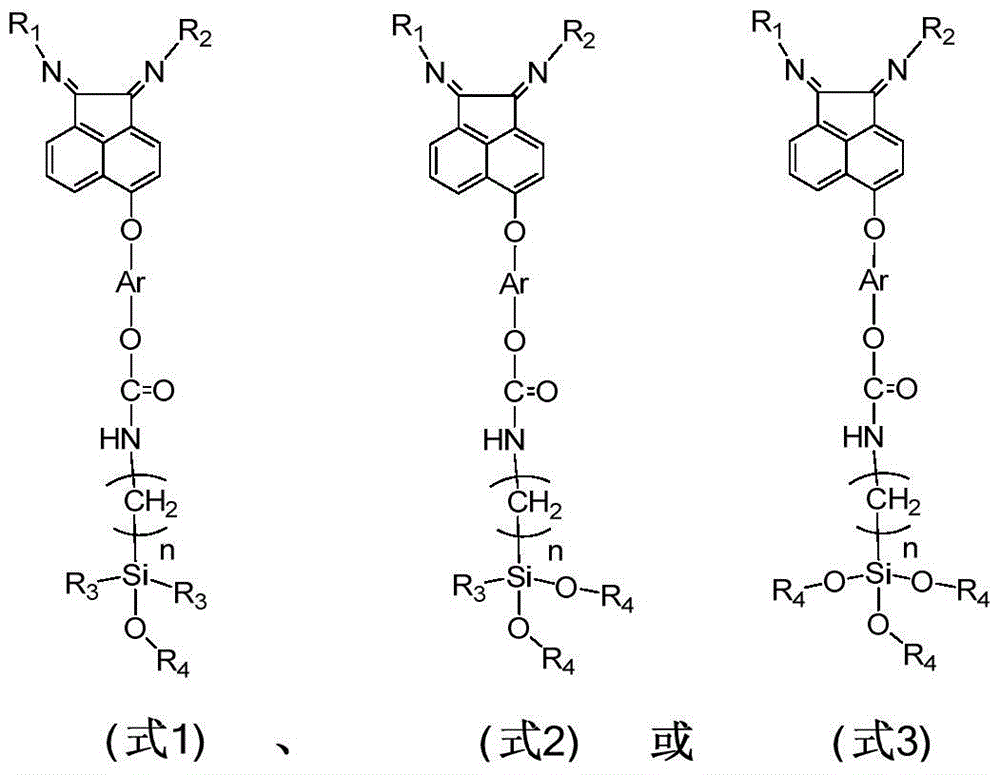A kind of α-diimine compound with alkoxy silicon and its application of supported metal complexes
A technology of diimine compounds and metal complexes, applied in the direction of iron organic compounds, nickel organic compounds, compounds of elements of Group 4/14 of the periodic table, etc. Poor stability and other problems, to achieve the effect of strong chemical bond force, reduced impact, and good thermal stability
- Summary
- Abstract
- Description
- Claims
- Application Information
AI Technical Summary
Problems solved by technology
Method used
Image
Examples
Embodiment 1
[0034] Synthesis of load e1
[0035] Its preparation route is as follows:
[0036]
[0037] Synthesis of acenaphthoquinone b1:
[0038] Add 13.1g (50mmol) of 5-bromoacenaphthylquinone in the reaction bottle of 100mL, 20.7g (150mmol) K 2 CO 3 , 50 mL of dry DMF, and start stirring. Add 13.8g (100mmol) a1 during the stirring process, react at 60°C, the reaction is stopped after the chromatographic trace traces that the reactants have completely reacted. Pour the dark brown solution of the reaction into a saturated NaCl solution to become a brown suspension, extract 2-3 times with dichloromethane, and use anhydrous MgSO for the organic phase 4 After drying, the solvent was distilled off under reduced pressure to obtain 15 g of brown crystals of compound b1 (that is, the structure of compound B, where Ar=4-ethylbenzene), with a yield of 94%. 1 H NMR (400MHz, CDCl 3 ): δ8.62(d, J=8.4Hz, 1H), δ8.16(d, J=7.0Hz, 1H), δ8.05(d, J=7.8Hz, 1H), δ7.89(t, J=7.8Hz, 1H), δ7.40(d, J=8...
Embodiment 2
[0046] Synthesis of load g1
[0047] Its preparation route is as follows:
[0048]
[0049] Acenaphthoquinone bis(2,6-diisopropyl)phenylimine c1 was synthesized according to the steps described in Example 1, and acenaphthoquinone bis(2,6-diisopropyl)phenylimine substituted with diethoxymethylsilane Amine f1 (that is, the structure of compound F, wherein Ar=4-ethylphenyl, R 1 = R 2 =2,6-diisopropylphenyl, R 3 = Methyl, R 4 =ethyl) is the same as the preparation process of triethoxysilane-substituted acenaphthoquinone bis(2,6-diisopropyl)phenylimide d1 in Example 1, and the specific synthesis steps of the load g1 are the same as that of the load g1 in Example 1. The synthesis steps of object e1 are the same. Elemental analysis of load g1: C, 22.17%; N, 1.55%.
Embodiment 3
[0051] Synthesis of load i1
[0052] Its preparation route is as follows:
[0053]
[0054] Acenaphthoquinone bis(2,6-diisopropyl)phenylimine c1 was synthesized according to the steps described in Example 1, acenaphthoquinone bis(2,6-diisopropyl)benzene substituted with monoethoxydimethylsilane Imine h1 (that is, the structure of the H compound, wherein Ar=4-ethylphenyl, R 1 = R 2 =2,6-diisopropylphenyl, R 3 = Methyl, R 4 =ethyl) is the same as the preparation process of triethoxysilane-substituted acenaphthoquinone bis(2,6-diisopropyl)phenylimide d1 in Example 1, and the specific synthesis steps of the load i1 are the same as those of the load i1 in Example 1. The synthesis steps of object e1 are the same. Elemental analysis of load i1: C, 15.19%; N, 1.06%.
PUM
| Property | Measurement | Unit |
|---|---|---|
| polymeric | aaaaa | aaaaa |
Abstract
Description
Claims
Application Information
 Login to View More
Login to View More - R&D
- Intellectual Property
- Life Sciences
- Materials
- Tech Scout
- Unparalleled Data Quality
- Higher Quality Content
- 60% Fewer Hallucinations
Browse by: Latest US Patents, China's latest patents, Technical Efficacy Thesaurus, Application Domain, Technology Topic, Popular Technical Reports.
© 2025 PatSnap. All rights reserved.Legal|Privacy policy|Modern Slavery Act Transparency Statement|Sitemap|About US| Contact US: help@patsnap.com



